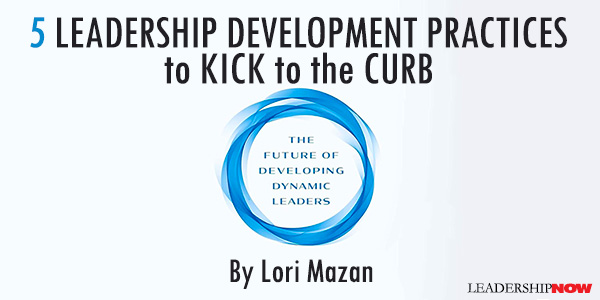 |
 |
11.27.23

5 Leadership Development Practices to Kick to the Curb
IN MY THIRTY YEARS as an executive coach, I have seen a lot of change — the complete digital transformation of the workplace, increased diversity of the labor market, the shifting role of employers. But one thing that has largely remained unchanged has been the approach to leadership development. Even though the world looks nothing like it did 30 years ago, organizations still cling to strategies and methodologies developed in the 20th century. Here are five outdated practices that organizations need to kick to the curb immediately: 1. Limiting the definition of leadership Many have asked me how to define a leader, but I have refused. There is no one way to be a leader. Effective leadership does not rely upon a standard set of characteristics like charisma or aggressiveness. Narrowly defining leadership restricts innovation by excluding countless points of view and modes of operating. Yet, many learning and development strategies are built towards forcing leaders to fit themselves into a restrictive mold. When leaders are pressured into leadership styles that go against their natural way of operating, they are set up for failure. It’s like wearing a set of clothes that don’t fit. Leaders feel self-conscious and uncomfortable. They end up focusing on themselves instead of the people and organization they are leading. Opening the definition of leadership empowers leaders to play to their strengths rather than confining them to operate within a set style. And it opens the door to greater diversity in the leadership ranks and pipeline. 2. Focusing solely on skill development Early in my career, I worked as a corporate trainer. Sessions were standardized training with 30 or more participants working on building skills or horizontal development. After the sessions, there was time for questions, and often, I would be asked, “This is great, but how do I actually use this in my day-to-day?” Vertical development answers that question by building a leader’s capabilities and capacities. Capabilities are sets of skills and the ability to apply these within the context of the moment. Capacity is a leader’s ability to contain, manage, or affect change in the evolving circumstances within their role. Traditional training and skill development are needed, but without vertical development to contextualize the use of these skills, leaders will fail to transfer these skills into their daily routines. In short, without vertical development, training dollars are wasted. 3. Using standard 360 assessment tools Most assessment tools — like most leadership development models — were created in the last century and no longer accurately reflect a leader’s developmental needs. The typical 360 assessment is too linear and only provides a snapshot of the leader at a single point in time. They provide limited value in our current fast-paced, complex, constantly changing, non-binary business environment. Organizations need a way to measure and track a leader’s development over time rather than a one-and-done assessment. Assessments should rely on a feedback loop from leaders, managers, and coaches to evaluate and track progress. Insights could then be used to develop new goals, creating a continuous learning experience. 4. Relying on ranked or traditional performance evaluations In the early 2000s, companies were beginning to abandon performance evaluations because they provided very little helpful information regarding talent decisions and development. Typically, evaluation scores are determined subjectively, which can often lead to disagreements between managers and direct reports on whether expectations are being met. Performance evaluations are also a massive drain on manpower and resources. Yet, having no alternative, performance evaluations have once again become popular because organizations feel they must “do something” to evaluate workers. Our company has decided to leave performance evaluations in the past where they belong. We have opted for manager/employee alignment tools. Instead of relying on a once-a-year subjective evaluation, our leaders work regularly with direct reports to ensure that everyone on the team is aligned to the same priorities, goals, and objectives. 5. Manually managing leadership development programs I recently hosted a webinar and polled the audience on how they managed their programs, and more than half of the respondents said they either used spreadsheets or manually tracked everything. When programs are manually managed, the cost and labor associated with development programs become unsustainable. Worse, manual management opens the door to human errors like coach or mentor mismatches, mis-scheduling, and loss of data. With today’s technology, there is absolutely no excuse to manage leadership development programs manually. A well-designed leadership development platform can eliminate the pitfalls associated with manual management, while also increasing engagement among leaders. Technology can eliminate the guesswork when matching coaches and coachees, scheduling, and tracking development. The right platform will provide a throughline between development and return on investment. Is your organization guilty of clinging to these outdated practices? If so, it’s time to finally get your company’s leadership development into the 21st century. Failing to do so will guarantee a weak leadership bench that is unprepared to adapt and thrive within today’s ever-changing economic environment.  
Posted by Michael McKinney at 07:45 AM
|
BUILD YOUR KNOWLEDGE


How to Do Your Start-Up Right STRAIGHT TALK FOR START-UPS 
Grow Your Leadership Skills NEW AND UPCOMING LEADERSHIP BOOKS 
Leadership Minute BITE-SIZE CONCEPTS YOU CAN CHEW ON 
Classic Leadership Books BOOKS TO READ BEFORE YOU LEAD |